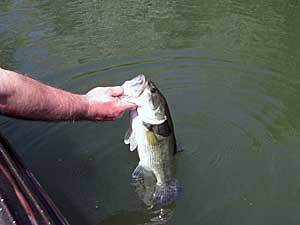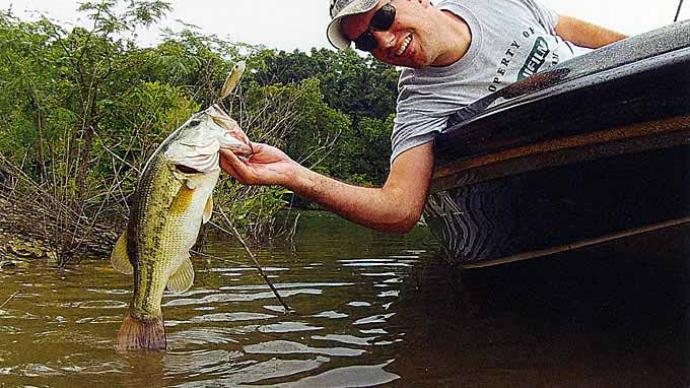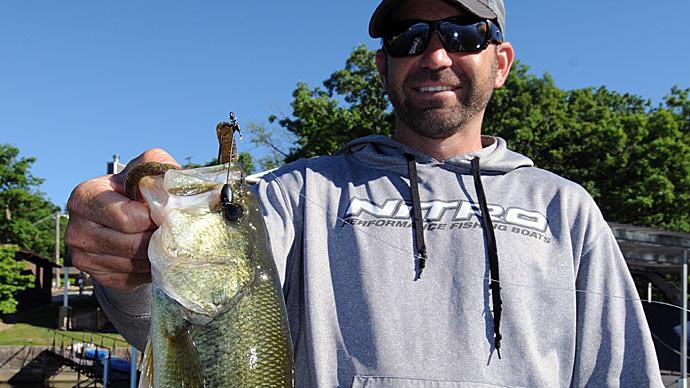
The split shot rig is a finesse version of a fish-finding rig along the lines of the Carolina rig. Too many anglers dismiss this method as too slow or a small fish method. It is a deadly finesse method that can cover water as efficiently and as quickly as the Carolina rig. The split shot method also is a great way to catch limits of keeper-sized bass. What tournament angler could dispute the success of that?
Split shotting is a finesse technique that works best in depths under 20 feet. It can be worked deeper, but the sensitivity decreases as the depth increases. The split shot rig is nothing like traditional worm fishing for anglers who aren't confident in their worm fishing abilities.
This is a cast and crank method that can be more quickly than crankbait fishing than worm fishing. The tiny 4-inch curly-tailed worms are in constant motion on the bottom, so it might be even more effective than cranking because the bait stays in the strike zone longer.
However simple this may sound, you can increase the technique's effectiveness by "seining the bottom." I mean using different casting angles and boat positioning to saturate a grid or area. You can potentially present the bait to every fish within a determined area.
Not Just Another Carolina Rig
The split shot may resemble a Carolina rig, but it is different. To tie the rig, you must eliminate the bullet sinker. Instead, you crimp a piece of the shot, two or three feet above the Texas-rigged bait. I often distance the shot about 18 to 24 inches above the bait. It is essential to use only round shots without the tabs. The tabs will always catch on the weeds and foul the rig. Use size 2 or 4 shot. Make sure you don't fray the line when you crimp the shot down on it. I prefer a softer shot to prevent damaging the line.
This is a proper finesse rig. Using this rig requires an angler to scale down their tackle. A four-inch bait is about the largest an angler should use. Employ a size 1/0 or size 1 Aberdeen style hook. Rig the bait on the seam. This, along with the Aberdeen hook, is a straight shank style and creates a keel to prevent the bait from rolling, thus eliminating line twists. That is the key to the natural swimming motion of this bait. Fine diameter lines and light spinning gear are necessary for this technique. I use a 7- or 7-foot 6-inch medium-light spinning rod and 6-pound test for this technique.
Employ the split shot rig when fishing in depths shallower than 20 feet. Any deeper, and you'll lose contact with the bait. The split shot retrieve is slow and steady. Maximum bottom contact is essential. You have to keep the weight in contact with the bottom. This technique is perfect for locating concentrations of bass. Especially when coordinated to cover a specific area from multiple angles. The wind won't hamper its success because the bait is always in motion. Wind can put a severe damper on regular worm fishing such as a Texas rig. The split shot rig is less affected by wind because you are constantly moving it.
Split shotting is deadly when fishing uses water. If I'm fishing behind another boat, the chances are that I am throwing a split shot rig to the water that has already been covered by that boat. The split shot method excels in heavily fished waters. That is the beauty of this method.
One area in which this method excels is locating fish around uninteresting areas. Most anglers will beat visible cover or structure they see on their LCDs to death. While you can catch fish in these places on split shot rigs, the rig may be better suited for use in dull areas without heavy cover. Other anglers usually pass over these dull areas, and they likely don't receive any exploration because they can't see anything attractive to hold bass.
One particular day I was on an 85-acre pond hosting a bass tournament by a local B.A.S.S. chapter. The water was crowded with 15 or so boats, and all of the water was used up. Immediately I rigged a split shot worm, and I proceeded to catch a limit of decent bass. From what I heard, the participants didn't fair as well. This proved to me how valuable an option this rig is. It took fish in water that was used by skilled anglers. This rig is a good choice when trying to locate fish on an unfamiliar lake. It is often the first tactic I'll try on new waters. When a cold front is passing through, the split shot may be the only bait that gets consistent attention from bass.
Anglers must learn to recognize the strike on a split shot rig. It differs from the telltale tap-tap of the Texas rig. The split shot bite tends to feel like a mushy sensation or the feeling of added pressure on the line. Bass tend to hold onto the bait a bit longer than traditionally rigged worms. The lack of a sliding weight for a bass to feel in its mouth likely is the reason. This setup is just more natural. As with many of the techniques in this book, it might be best to learn what the rig feels like being retrieved unimpeded. Because you will be bumping off the bottom with it, you may be in for a tough time recognizing strikes. Remember that hook sets are free and if you feel anything out of the ordinary, swing on it.
One caution with this rig, because you are using a light line, try to sweep set the rod sharply to one side of your body. I utilize a set similar to the Slider sweep. You do not want to pop your line by setting too hard with the tiny line. Bass seem to hold on to the bait because of the weightless feeling and the small slackline between the split shot and the bait.
Hand-poured worms and standard grubs, reapers, and lizards work well on a split shot rig. One of the best worms for this is the Curly Tail worm from Robo Worm. This is made specifically for the shot techniques. This is a tiny 4-inch worm that features some wicked hand-poured colors. It has a curly tail that is rigged tail down to offset any line twist by being in line with the keel that the Aberdeen hook creates. The worms are scented and salted, and bass do not drop them once they strike.
Anytime is split shot time
An angler should recognize the best times to use this method. I use it as a fish-finding tool on unfamiliar waters. If you put an easy meal in front of any bass, it will tell you something every time. If you are patterning fish incorrectly, the rig may not be helpful to you. If you use it where they live, it will draw a reaction and usually quickly at that. I initially target sloping primary and secondary points with the rig. I move to small shallow humps, sand bars and depressions, flats, and sandy bottom areas.
One of the best places to utilize the split shot rig is on bare or nothing banks. These areas visually don't look as sweet as a submerged log jam or weed bed. For this reason, they are often overlooked and passed by most target fishing anglers. The truth is that bass will be in these areas, and often it is because the bottom offers something that the target angler doesn't even know is there.
When pulled over shallow flats, sloping points, sandy banks, boat launch ramps, and sandbars, the rig also works well. Try it in non-traditional fishing spots. Locate daily migration routes and try this rig. Traditional baits won't raise a strike; the split shot rig may be just the ticket to catching a bass with lockjaw. Target spots that other fishermen ignore; bare banks, swimming areas, and shallow sandy flats are among the choicest of areas.




